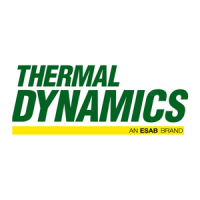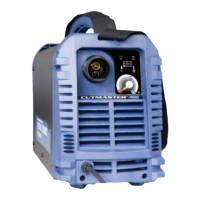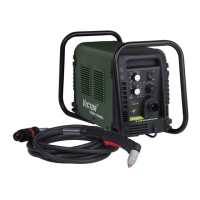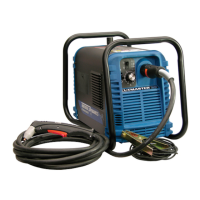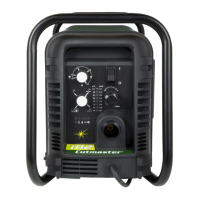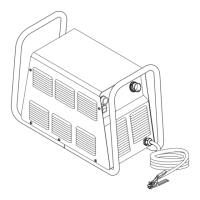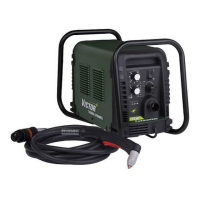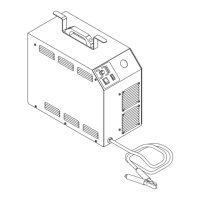CUTMASTER 35mm, 40mm
Manual 0-5118 4T-3 OPERATION
Torch Standoff
Improper standoff (the distance between the torch
tip and workpiece) can adversely affect tip life as
well as shield cup life. Standoff may also signifi-
cantly affect the bevel angle. Reducing standoff
will generally result in a more square cut.
Edge Starting
For edge starts, hold the torch perpendicular to
the workpiece with the front of the tip near (not
touching) the edge of the workpiece at the point
where the cut is to start. When starting at the edge
of the plate, do not pause at the edge and force the
arc to "reach" for the edge of the metal. Establish
the cutting arc as quickly as possible.
Direction of Cut
In the torches, the plasma gas stream swirls as it
leaves the torch to maintain a smooth column of
gas. This swirl effect results in one side of a cut
being more square than the other. Viewed along
the direction of travel, the right side of the cut is
more square than the left.
Side Characteristics Of Cut
To make a square - edged cut along an inside
diameter of a circle, the torch should move coun-
terclockwise around the circle. To keep the square
edge along an outside diameter cut, the torch
should travel in a clockwise direction.
Dross
When dross is present on carbon steel, it is com-
monly referred to as either “high speed, slow
speed, or top dross”. Dross present on top of
the plate is normally caused by too great a torch
to plate distance. "Top dross" is normally very
easy to remove and can often be wiped off with
a welding glove. "Slow speed dross" is normally
present on the bottom edge of the plate. It can vary
from a light to heavy bead, but does not adhere
tightly to the cut edge, and can be easily scraped
off. "High speed dross" usually forms a narrow
bead along the bottom of the cut edge and is very
difficult to remove. When cutting a troublesome
steel, it is sometimes useful to reduce the cutting
speed to produce "slow speed dross". Any resul-
tant cleanup can be accomplished by scraping,
not grinding.
4T.04 Hand Torch Operation
Standoff Cutting With Hand Torch
NOTE
For best performance and parts life, always use
the correct parts for the type of operation.
1. The torch can be comfortably held in
one hand or steadied with two hands.
Position the hand to press the Trigger on
the torch handle. With the hand torch,
the hand may be positioned close to the
torch head for maximum control or near
the back end for maximum heat protec-
tion. Choose the holding technique that
feels most comfortable and allows good
control and movement.
NOTE
The tip should never come in contact with
the workpiece except during drag cutting
operations.
2. Depending on the cutting operation, do one
of the following:
a. For edge starts, hold the torch perpen-
dicular to the workpiece with the front
of the tip on the edge of the workpiece
at the point where the cut is to start.
b. For standoff cutting, hold the torch 1/8
- 3/8 in (3-9 mm) from the workpiece
as shown below.

